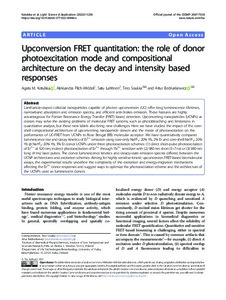Upconversion FRET quantitation: the role of donor photoexcitation mode and compositional architecture on the decay and intensity based responses
Pilch-Wróbel Aleksandra; Lahtinen Satu; Bednarkiewicz Artur; Kotulska Agata M.; Soukka Tero
Upconversion FRET quantitation: the role of donor photoexcitation mode and compositional architecture on the decay and intensity based responses
Pilch-Wróbel Aleksandra
Lahtinen Satu
Bednarkiewicz Artur
Kotulska Agata M.
Soukka Tero
SPRINGERNATURE
Julkaisun pysyvä osoite on:
https://urn.fi/URN:NBN:fi-fe2022091358907
https://urn.fi/URN:NBN:fi-fe2022091358907
Tiivistelmä
Lanthanide-doped colloidal nanoparticles capable of photon upconversion (UC) offer long luminescence lifetimes, narrowband absorption and emission spectra, and efficient anti-Stokes emission. These features are highly advantageous for Forster Resonance Energy Transfer (FRET) based detection. Upconverting nanoparticles (UCNPs) as donors may solve the existing problems of molecular FRET systems, such as photobleaching and limitations in quantitative analysis, but these new labels also bring new challenges. Here we have studied the impact of the core-shell compositional architecture of upconverting nanoparticle donors and the mode of photoexcitation on the performance of UC-FRET from UCNPs to Rose Bengal (RB) molecular acceptor. We have quantitatively compared luminescence rise and decay kinetics of Er3+ emission using core-only NaYF4: 20% Yb, 2% Er and core-shell NaYF4: 20% Yb @ NaYF4: 20% Yb, 5% Er donor UCNPs under three photoexcitation schemes: (1) direct short-pulse photoexcitation of Er3+ at 520 nm; indirect photoexcitation of Er3+ through Yb3+ sensitizer with (2) 980 nm short (5-7 ns) or (3) 980 nm long (4 ms) laser pulses. The donor luminescence kinetics and steady-state emission spectra differed between the UCNP architectures and excitation schemes. Aiming for highly sensitive kinetic upconversion FRET-based biomolecular assays, the experimental results underline the complexity of the excitation and energy-migration mechanisms affecting the Er3+ donor responses and suggest ways to optimize the photoexcitation scheme and the architecture of the UCNPs used as luminescent donors.
Kokoelmat
- Rinnakkaistallenteet [19207]
